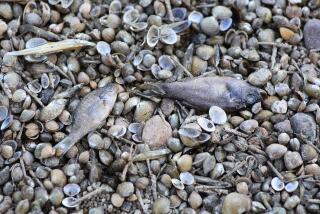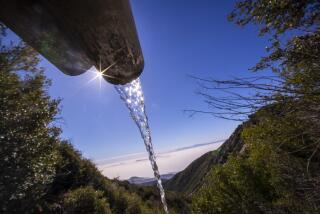Issues Collide in Plan to Dam Buffalo River
- Share via
MARSHALL, Ark. — Ben Fruehauf is worried.
His livelihood as a canoe outfitter depends on the Buffalo National River, a majestic, free-flowing watercourse rich with 59 species of fish and flanked by caves tucked deep inside towering limestone bluffs.
He doesn’t want anyone altering the water flow. It is already fickle enough.
Fruehauf lives in Searcy County, nestled in the heart of the Ozarks and home to about 8,200 people spread over 664 square miles of rolling hills and pastures. The state Health Department found that much of the county’s water supply is tainted with naturally occurring radium, a known carcinogen.
A plan to resolve the water problems has pitted the U.S. Army Corps of Engineers against the National Park Service and stoked the debate over growth and development versus conservation.
Congress designated the Buffalo as the nation’s first national river in 1972, but long before then the area was home to farmers and early settlers. Indians made homes in caves in the bluffs. The hollows flanking the river even served as hide-outs for soldiers during the Civil War.
During the dry season or times of drought, the springs that feed the Buffalo either run dry or have a reduced water flow. As a result, towns such as Marshall and Leslie, which depend on the springs, must cut back on water consumption.
With the reduced flow, there is also less water to dilute the radium. The result is higher radium levels that pose a risk, although no cause for alarm.
“We think it is highly unlikely you would ever be able to link cancer to it because of the small amount of people drinking it versus the extremely small level of risk--one in a million,” said Harold Seifert, director of the state Health Department’s engineering division.
In an effort to provide potable water to these Ozark mountain towns, the Searcy County Regional Water District devised a plan to dam Bear Creek, the Buffalo’s largest tributary, creating a lake for water supply.
Over the years, due to cost restraints, the plan was whittled to a 92-acre, 60-foot-deep reservoir with a spillway dam located 26 miles from the river.
The Little Rock office of the Army Corps of Engineers denied the district’s permit request last year, citing adverse environmental effects. It seemed to side with the National Park Service and the U.S. Fish and Wildlife Service, opponents of the dam.
The park service estimates that 1 million people visit the Buffalo National River annually, contributing up to $36 million to the local economy. A dam at Bear Creek, it said, would cut off about 15% of the water flow down the stream, interrupting fish migration in one of the nation’s richest areas for fish species.
The water district appealed.
The corps commander in Little Rock held firm, but Gov. Mike Huckabee weighed in with his support for a dam and reservoir that could be the first in the Buffalo National River watershed. That automatically sent the issue to the corps’ division headquarters in Dallas.
That office, reversing the corps in Little Rock, approved the permit for the dam in late July.
And so the stage was set for a showdown that the Justice Department could be called on to resolve, according to John Haubert, an outdoor recreation planner with the National Park Service headquarters in Washington.
“What is unusual with this situation is that I don’t know of any instance where the corps has permitted a dam in a national wild and scenic river or national river over the objections of the park service,” Haubert said. “From that standpoint, I’d say this is precedent-setting.”
Don Barger, southeast regional director of the National Parks Conservation Assn., which opposes the dam, said the decision is symbolic of the Bush administration’s environmental policies.
Although the administration has committed $4.9 billion to the park system, he said, most of the funds will be “targeted toward bricks and mortar, building roads as opposed to resource protection. . . . I think this could be an example of that.”
Barger has said his group would not rule out legal action to protect the Buffalo River, one of the few remaining free-flowing rivers in the lower 48 states. It starts as just a trickle from the ground in the Boston Mountains of Arkansas before winding its way east in swift-running and placid stretches through the Ozarks. It empties 150 miles away into the White River.
Michael Baker, president of the water district, has lived in Searcy County his entire life. His efforts to create a better water supply for the county date back to the 1970s.
The dam, he said, would provide potable water for at least 50 years. “All I can see are benefits,” he said.
But when the Buffalo River won the national designation, legislation called for the park service to preserve it as a “free-flowing stream.”
A dam on Bear Creek, conservationists say, would lower water levels in the Buffalo and could kill off fish species.
“We’re basically at the point where we’re making final decisions on whether we’re going to have living streams for the future,” Barger said.
U.S. Rep. Marion Berry, whose district includes Searcy County, said there is no scientific evidence that the dam would have any impact on the river.
“The amount of water coming out of Bear Creek doesn’t amount to a thimble in the ocean,” he said. “If the park service doesn’t want the Bear Creek dam to be built, then they should have to pay for the alternative.”
More to Read
Sign up for Essential California
The most important California stories and recommendations in your inbox every morning.
You may occasionally receive promotional content from the Los Angeles Times.










